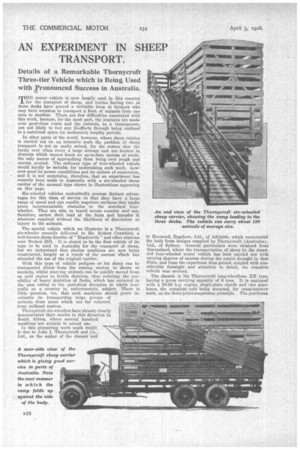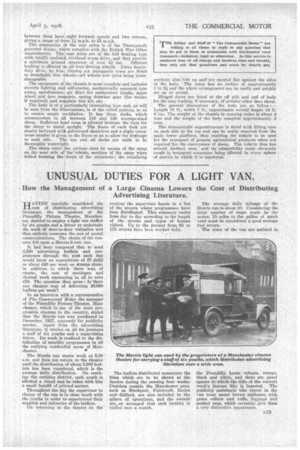AN EXPERIMENT IN SHEEP TRANSPORT.
Page 52

Page 53

If you've noticed an error in this article please click here to report it so we can fix it.
Details of a, Remarkable Thornycroft Three-tier Vehicle which is Being Used with Pronounced Success in Australia.
METE motor vehicle is now iargely used in this country 1 for the transport of sheep, and lorries having two or three decks have proved a veritable boon to farmers who may have occasion to transport a flock of animals from one area to another. There are few difficulties associated with this work, because, for the most part, the journeys are made over good-class roads and the animals, as .a consequence, are not likely to feel any ill-effects through being confined in a restricted space for moderately lengthy periods.
In other parts of the world, however, where sheep raising is carried out on an intensive scale the problem of sheep transport is not so easily solved, for the reason that the fare's very often cover a large acreage and are located in districts which cannot boast an up-to-date system of roads, the only means of approaching them being over rough and uneven ground. The ordinary type of four-wheeled vehicle would hardly be suitable for undertaking such work, however good its power capabilities and its system of suspension, and it is not surprising, therefore, that an experiment has recently been made in Australia with a six-wheeled sheep carrier of the unusual type shown in illustrations appearing on this page.
Six-wheeled vehicles nadoubtediy possess distinct advantages for this class of service in that they have a large range of speed and can readily negotiate surfaces that might prove insurmountable obstacles to the standard fourwheeler. They are able to travel across country and can, therefore, secure their load at the farm and transfer it wherever required without the likelihood of discomfort or injury to the animals.
The special vehicle which we illustrate is a Thornycroft six-wheeler recently delivered to Mr. Robert Crawford, a well-known sheep breeder of " Bimbowrie " and other stations near Broken Hill. It is stated to be the first vehicle of its type to be used in Australia for the transport of sheep, but we understand that similar machines are now being constructed, largely as a result of the success which has attended the use of the original carrier.
With this type of vehicle pedigree or fat sheep can he transported direct from the rearing station to shows or markets, whilst starving animals can be quickly moved from an arid region to fertile districts, thus reducing the possibility of heavy depletion of flocks, which has occurred in the past owing to the periodical droughts to which Australia as a country is, unfortunately, subject. There is little question, too, that such machines should prove invaluable in transporting large groups of animals from areas which are far removed from railhead centres.
Thornycroft six-wheelers have already clearly demonstrated their merits in this direction in South Africa, where several hundred machines are already in actual use.
In this pioneering work much credit is due to John I. Thornycroft and Co., Ltd., as the maker of the chassis and to Horwood, Bagshaw, Ltd.. of Adelaide, which constructed the body from designs supplied by Thornycroft (Australia), Ltd., of Sydney. General particulars were obtained from Queensland, where the transportation of sheep by the standard four-wheeled motor vehicle has beet carried out with varying degrees of success during the recent drought in that State, and from the experience thus gained, Coupled with considerable foresight and attention to detail, the complete vehicle was evolved.
The chassis is the Thornycroft long-wheelbase XB type, having a gross carrying capacity of 6 tons. It is equipped with a 50-60 h.p. engine, single-plate clutch and two gearboxes, the complete unit being mounted, for cross-country work, on the three-paint-suspension principle. The gearboxes
between them have, eight forward speeds and two reverse, giving a range of frOM 1 mph : to 25 m.p.h. The suspension eif the rear axles is of the Thornycroft patented design, which complieswith the British War Office requirements. The rear axles are of the full floating type with totally enclosed overhead Worm drive, and they provide a minimum ground clearance of over 12 ins.' Efficient braking is effected on all four driving wheels. Extra heavyduty 40-in. by 8-in. Dunlop s.s. pneumatic tyres are fitted to detachable disc wheels—all wheels 'and tyres being interchangeable.
The equipment of the chassis is most complete and includes electric lighting and self-starter, mechanically operated tyre pump, speedometer, air filter for carburetter intake, spare wheel and tyre complete, spring drawbar gear (for trailer if required) and complete tool kit, etc. The body is of a particularly interesting type and, as will be seen from the illustrations, is of the railed pattern, so as to ensure ample ventilation. It has three decks, which accommodate in all between 110 and 120 average-sized sheep. Sufficient bead room is allowed between the tiers for the sheep to stand upright. The floors of' each deck are closely battened with galvanized sheet-iron and a slight transverse camber is given to the floors so as to allow for drainage to each side. The to and all decks are made to be thoroughly watertight.
The sheepcenter the various tiers by means of the ramp on the near side of the'-vebicle, sections of the ramp when folded forming the doors of the entrances ; the remaining
portions also fold up and are carried flat against the sides of the body. The ramp has an incline of approximately 1 in 24 and the whole arrangement can be easily and quickly Set up or stored.
Hinged doors are fitted at the off side and end of body for the easy loading, if necessary, of articles other than sheep.
The general dimensions of the body are as follow :— Length 18 ft., width 7 ft., approximate overall height 14 ft. 6 ins. The weight of the chassis in running order is about 4 tons and the weight of the body, complete approximately 2 tone.
The demountable superstructure is fitted -with lifting eyes on each side at the top and can be easily removed from the main lower platform, thus enabling the vehicle to be used for the transport of general agricultural products when not required for the conveyance' of sheep. The vehicle thus has several distinct uses, and its 'adaptability mustobviously result in transport economies being effeeted in' eVery's.phere of service in -Which it is employed. .




















































































































